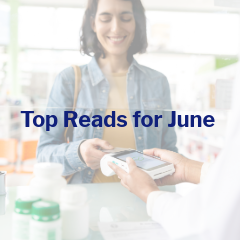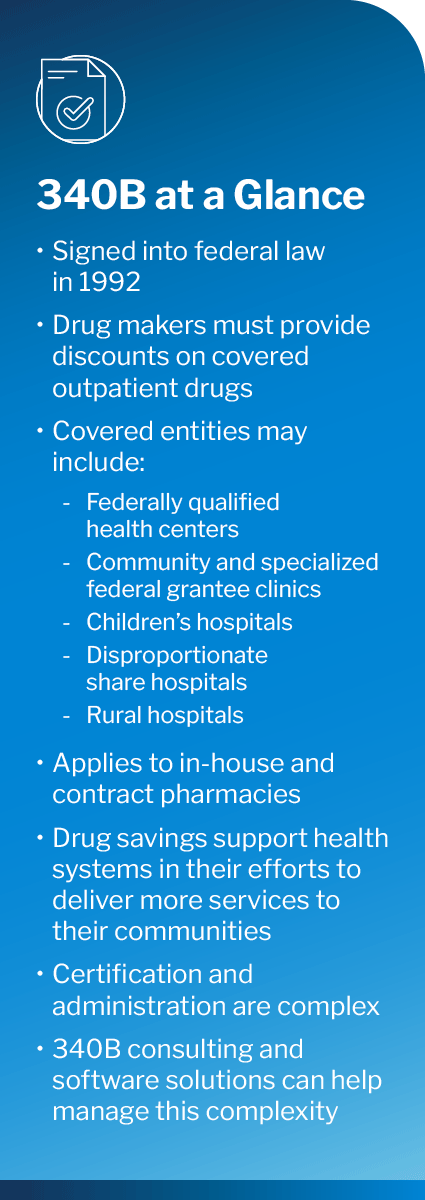
The top three Prescribed Perspectives articles downloaded by health systems in June.
Quick facts about the complex 340B Drug Pricing Program.
By
Date
November 23, 2021

By: Andrew Wilson, Chris Shain, and Heather Easterling
Read time: 5 minutes
The federal 340B Drug Pricing Program has been helping covered entities expand and enhance services for underserved populations since 1992. The idea was simple — to require manufacturers to discount outpatient drugs for hospitals serving large numbers of poor and uninsured patients. Yet as the program expanded to cover more sites of care, the administrative complexity of 340B grew exponentially. For health systems just beginning to consider participation in the program, getting mired in the details too quickly can be overwhelming. By taking a step back to understand the basics of 340B, administrators can more easily weigh the core benefits and common challenges before taking the next steps forward. For a full list of 340B-eligible organizations, visit hrsa.gov.
The 340B Drug Pricing Program requires drug manufacturers to provide discounts directly to covered entities as a condition of their participation in Medicaid and Medicare Part B. It’s just one part of a safety net designed to support healthy communities. And while the program is administered by the federal government, these discounts are provided at no direct cost to taxpayers.

When 340B began, eligibility was tightly focused on traditional safety-net hospitals, outpatient clinics and community health centers. The program was so successful, it was expanded to include children’s hospitals, rural hospitals and many other points of care. Participation is not automatic, however. Prospective entities must first register for 340B participation through the Office of Pharmacy Affairs under the Health Resources & Services Administration.
From rural hometown hospitals to large urban health systems, each community has its own unique mix of demographic and economic conditions to navigate. And according to 340B guidelines, participating organizations have a great deal of flexibility in how they choose to channel their savings. Strategies may include:
As the program has grown and evolved to broaden eligibility, it has also grown in complexity. Drugs that are eligible for 340B pricing at one site of care may not be eligible when administered at another within the same health system. There are also specific guidelines for how health systems should bill Medicare, Medicaid and private insurance companies. And issues like duplicate discounts — such as when both a 340B discount and a Medicaid rebate are requested for the same drug — are a perennial source of concern. Additionally, the ambiguity of some sections of the program has even sparked legal challenges as covered entities and pharmaceutical companies bring their own interpretations to bear.

Despite its designation as a drug pricing program, 340B works best when stakeholders throughout the health system work together to increase the positive impact on community health. Rather than simply leaving 340B decision-making to pharmacy leaders, it’s important to bring the C-suite into the conversation. When executives understand what the projected cost savings and revenues could be, they can begin to devise informed strategies about how and where to allocate funds. Developing an independent 340B oversight committee is another way to help ensure that decisions driven by 340B also work for parts of the organization that are not covered entities. Committee membership should include a seasoned pharmacy leader, technology leaders, compliance and legal resources, as well as team members skilled in the business and science of medicine.
Beyond the administrative burden of compliance, the opportunities to increase both savings and revenue are tasks that also require targeted solutions. Specialized 340B software can be an invaluable tool to properly track drug purchases, discounts, savings and key analytics. Ideally, any software initiatives would be implemented as part of a strategic engagement by a knowledgeable partner such as McKesson, whose 340B specialists can help health systems improve savings and efficiencies across the continuum of care.
The 340B program is a unique business venture that requires a comprehensive approach to help set health systems up for success. As hospital leaders begin to weigh their 340B consulting options, they should look for a proven partner that can help their health system:
As a leading distribution partner and 340B champion, these are just a few of the consulting strengths that McKesson brings to the table. McKesson’s 340B consultants are nationally recognized experts in the field whose experience rivals all in the market.

Despite its complexity, the 340B Drug Pricing Program can offer tremendous advantages to health systems willing to invest the necessary time and resources to support success. The importance of meticulous oversight and accountability cannot be overstated. At the same time, overly risk-averse 340B strategies could stifle potential savings and revenue gains. As your health system weighs the potential benefits and drawbacks of participation, don’t hesitate to contact a trusted consulting partner to help you do the most good in your community through 340B.
Learn more about 340B consulting solutions at McKesson.com.